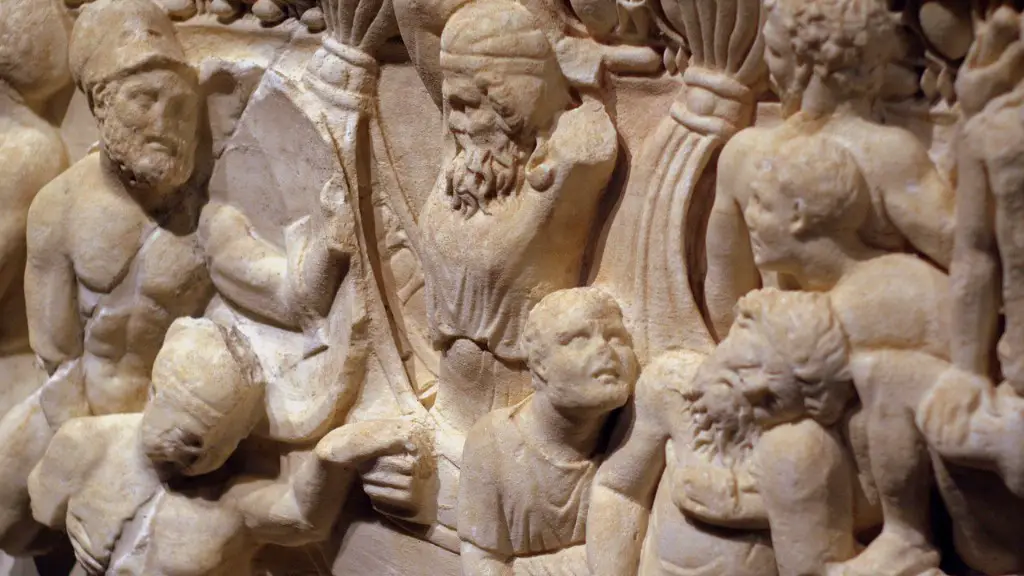In ancient Rome, a vomitorium was a constructed room or passageway specifically designed to facilitate mass movement of large numbers of people during crowded events at the amphitheater. It was located underneath or behind an upper tier of seating of the amphitheater, and was fronted by a row of fountains used to wash away blood and other filth that had been condemned after a gladiatorial fight. Vomitoria have been discovered in various locations throughout the ancient Roman world, and they have been researched and studied by archaeologists in order to gain a better understanding of their purpose, design and function in ancient Roman society.
In Latin, the word vomitorium literally means ‘to vomit’; however, there is evidence to suggest that the purpose of these spaces was not to induce vomiting among the audience. Instead, vomitoria were used to allow for the rapid and efficient evacuation of large crowds from the amphitheater. As a result, the amphitheater could be rapidly emptied in the event of a disturbance or to facilitate the movement of spectators from one event to the next. Vomitoria allowed for these large crowds to quickly and easily move from their seating areas and disperse into nearby areas.
Archaeological evidence has also suggested that vomitoria were also utilized as a logistics center by providing food, beverages, and even entertainment to patrons. The presence of a large number of drinking fountains in the vicinity of a vomitorium suggests that a variety of beverages were available to patrons. Additionally, several bricks and mortar remains of a vomitorium have been discovered at various sites with distinctive openings that suggest the possibility of vending services and entertainers providing food and various forms of entertainment. This evidence indicates that vomitoria provided more than just a quick exit point from the amphitheater; they were also used as an alternate destination for patrons as well.
The presence of vomitoria helps to provide insight into the typical structure of ancient Roman society and the importance of large, public events. It suggests a well-organized infrastructure enabling large numbers of people to safely move from one public event to the next. Furthermore, the presence of associated amenities such as food and beverage services and entertainment helps to further emphasize the importance of leisure of the Roman populace.
In conclusion, ancient Roman vomitoria were specially constructed spaces serving the purpose of preserving public order and facilitating the efficient movement of large crowds of people. They provided insight into the typical structure and importance of leisure activities in ancient Roman society and allowed for the quick and efficient evacuation of spectators in the event of a disturbance. The discovery of these spaces further helps to uncover the social, economic, and political complexities of the ancient Roman world.
Functions of a Vomitorium
As has been mentioned, the main purpose of a vomitorium was to rapidly move large numbers of patrons around and out of the amphitheater. This was done through the provision of many openings for spectators to exit the building and by maintaining order and control among spectators. The vomitoria could also be used as a place of egress from the amphitheater in the event of a disturbance or riot. This made it possible for large numbers of spectators to quickly evacuate the building and disperse into nearby areas in order to avoid harm. By facilitating this rapid evacuation, sternamitors preserved public order and ensured crowd control.
The presence of fountains in the vicinity of the vomitoria also suggests that other functions such as food and beverage distribution, and entertainment were also performed by these spaces. As mentioned earlier, the distinctives openings discovered in many vomitoria suggests the possibility of vending services and entertainers providing food and various forms of entertainment to those in attendance. This allows us to understand that the vomitoria were not solely utilized as an area for exit and entry, but were also places of rest, leisure and entertainment.
In addition to preserving public order, vomitoria were also seen as places of spiritual cleansing. As previously mentioned, the fountains in the vicinity of the vomitoria served as a means of washing away any blood and filth that had been condemned after a gladiatorial fight. This gesture of spiritual cleansing was thought to be a necessary condition of rendering humans clean before and after participating in the cruel gladiatorial games.
Purposes of Vomitoria
The primary purpose of vomitoria was to insure the efficient and safe evacuation of spectators from the amphitheater in the event of a disturbance. This enabled the rapid and orderly movement of large numbers of people which allowed for the preservation of public order. Additionally, vomitoria provided a social and leisure space for patrons, allowing them to partake in food, beverages, and entertainment.
Vomitoria were also places of religious and spiritual cleansing. The presence of drinking fountains in their vicinity suggests that refreshment and non-alcoholic drinks were available for patrons. Furthermore, the religious cleansing of spectators was thought to be a necessary requirement for participation in the gruesome gladiatorial games that were so prominent in ancient Roman society.
Design of Vomitoria
Archaeological evidence has suggested that vomitoria were designed differently depending on location. Generally, they consisted of a room or passageway located beneath the seating levels of the amphitheater, and contained multiple small openings providing quick and easy exit points. Row of drinking fountains were also a common feature in their vicinity. These small, contained spaces provided a quick and efficient means of evacuation in the event of an emergency, while providing social and leisure activities.
Vomitoria have been discovered in various locations throughout the ancient Roman world, including Ostia, Pompeii, and Rome. In each location, the specific design and layout of the vomitoria varied due to the varying structural requirements of the amphitheaters constructed. Furthermore, the drinking fountains and other amenities located in the vicinity of the vomitoria were also dependent on the location and the specific purpose of the vomitoria.
Conclusion
In conclusion, vomitoria were specially constructed spaces that served the purpose of allowing for the efficient and safe evacuation of large crowds from the amphitheater. They also provided insight into the typical structure and importance of leisure activities in ancient Roman society and allowed for the quick and efficient evacuation of spectators in the event of a disturbance. The discovery of these spaces further helps to uncover the social, economic, and political complexities of the ancient Roman world.



